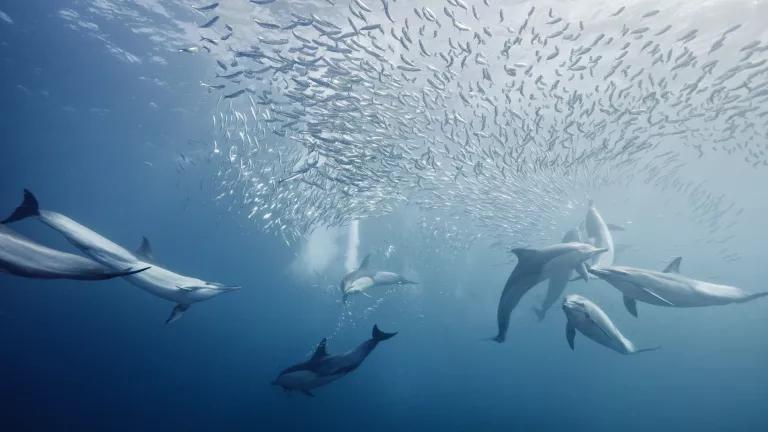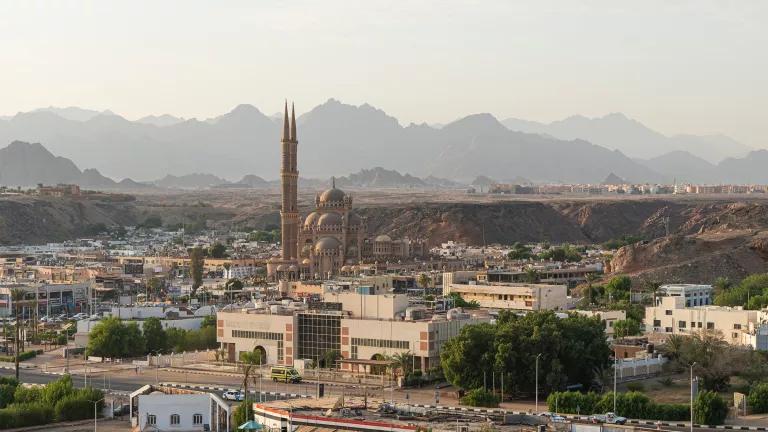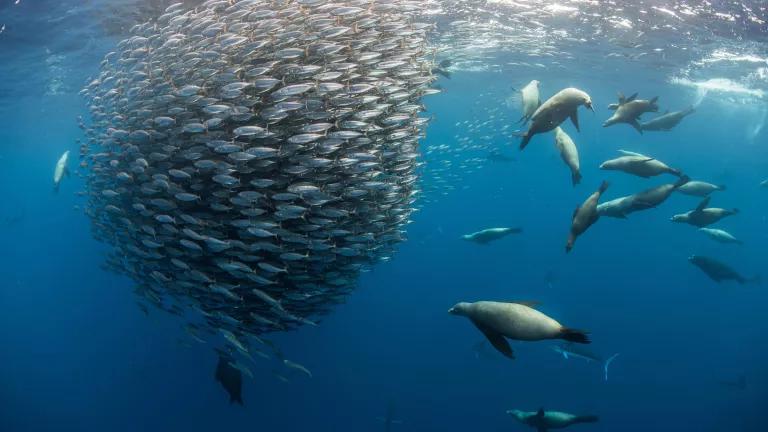Ocean Acidification Hot Spots
Ocean acidification, in which atmospheric carbon dioxide dissolves in seawater and creates an acid, poses a serious threat to the web of life underwater.

Ocean acidification, in which atmospheric carbon dioxide dissolves in seawater and creates an acid, poses a serious threat to the web of life underwater. But ocean acidification can seriously harm people as well by changing the ways we eat, earn a living, and support our communities. It has already cost the $110 million oyster industry in the Pacific Northwest significant amounts of money and jeopardized thousands of jobs. Yet relatively little attention has been paid to the human dimension of ocean acidification and fundamental questions about how ocean acidification will affect people remain unanswered. Who is going to be hardest hit by ocean acidification? In what ways will ocean acidification threaten their way of life? What actions can vulnerable communities take to protect themselves?
These maps display the results of a study we conducted to identify which coastal communities in the United States are most vulnerable to ocean acidification. The analysis focuses specifically on the potential economic and social impacts to communities that derive benefits from shelled mollusk harvests, which are particularly threatened by ocean acidification. We take a simple approach of mapping where the ocean chemistry is changing most rapidly, where vulnerable species are located, and where people who most depend on these species reside. The intersection of these factors reveals an elevated risk from ocean acidification.
Explore these maps to see if your community is at risk as a result of ocean acidification. If it is, examine why and consider actions you, your neighbors, and your legislators can do to reduce that risk. Observe how quickly water chemistry is changing off your shores from fossil fuel emissions and tally the local factors (such as coastal pollution) that might exacerbate these changes in your area. Consider elements that reduce the adaptive capacity of your community. An understanding of where and why regional impacts will occur is critical to preparing for a more acidic ocean. Click here for more information about the study.
Chemistry
Year water reaches chronically stressful conditions to shelled mollusks (aragonite saturation state 1.5) – 'a sufficiently high aragonite saturation state is a critical habitat feature for larval shelled mollusks to build their shells and survive; fossil fuel emissions reduces aragonite availability'
This map was constructed by Ruben van Hooidonk as part of the output from the following peer-reviewed scientific paper. For methods and model descriptions, see:
van Hooidonk, R. J., Maynard, J. A., Manzello, D. & Planes, S. Opposite latitudinal gradients in projected ocean acidification and bleaching impacts on coral reefs. Global Change Biology, 103-112, doi:doi:10.1111/gcb.12394 (2014).
Upwelling presence by marine province – 'natural currents churn up deep, acidic water onto coastlines'
This map was downloaded from DataBasin.org on August 1, 2013. The source listed and described is as follows:
These data were derived by The Nature Conservancy, and were displayed in a map published in The Atlas of Global Conservation (Hoekstra et al., University of California Press, 2010). More information at https://nature.org/atlas.
See reference:
Hoekstra, J. M., J. L. Molnar, M. Jennings, C. Revenga, M. D. Spalding, T. M. Boucher, J. C. Robertson, T. J. Heibel, with K. Ellison. 2010. The Atlas of Global Conservation: Changes, Challenges, and Opportunities to Make a Difference. Ed. J. L. Molnar. Berkeley: University of California Press
Rivers – 'River water with low aragonite saturation and high discharge volume raises acidity and reduces aragonite availability locally'
Data were not readily available nationwide that measured influence of river water on aragonite in coastal waters, therefore we estimated the influence with a calculation of river water discharge and measures used to calculate aragonite saturation state. Our methods are as follows:
River water discharged into the coastal zone can provide intermittent floods of corrosive , low Oar water, moving Oar closer to thresholds for shellfish. We estimated relative risk from river discharge with a measure that combined annual mean discharge volume (cubic feet) with mean aragonite saturation state of river water from USGS data (above the region of tidal influence). River pH, alkalinity (or acid neutralizing capacity), calcium concentration, and discharge flux at the farthest downstream USGS monitoring stations were obtained for the list of U.S. rivers studied in Stets and Striegl (2012) (P. Raymond, pers. comm.) from the USGS National Water Information System (NWIS). Because data were not always collected at the same times, even for different parameters at the same station, we averaged each river's time series of pH, alkalinity, temperature, and calcium, then used these approximate average values to calculate an approximate carbonate ion concentration with CO2SYS using freshwater constants. Approximate mean saturation state of aragonite was then calculated from the product of [Ca2+] and [CO32-] divided by the freshwater solubility product at average temperature. 126 sample sites reported both discharge volume and aragonite saturation and were used in the analysis. Discharge volume and saturation state for each station were log-transformed and re-scaled (0-1). An index of relative ocean acidification threat from river discharge was created by multiplying the transformed, normalized discharge by the inverse of the transformed, re-scaled saturation. This way, rivers with high discharge and low saturation state contributed to acidification highest threat in coastal zones.
Stets, T. and R. Striegl, 2012. Carbon export by rivers draining the conterminous United States. Inland Waters 2, pp. 177-184.
Estuary eutrophication score – 'Eutrophication occurs when excess nutrients from coastal pollution cause algae blooms; when these algae die and decompose water acidity increases locally'
Data source and methods described: Bricker, S., B. Longstaff, W. Dennison, A. Jones, K. Boicourt, C. Wicks, and J. Woerner. 2007. Effects of Nutrient Enrichment in the Nation's Estuaries: A Decade of Change. NOAA Coastal Ocean Program Decision Analysis Series No. 26. National Centers for Coastal Ocean Science, Silver Spring, MD. 328 pp. Available for download at https://ian.umces.edu/neea/ and https://ccma.nos.noaa.gov/publications/eutroupdate/
Dataset described
This map is the eutrophication scores received from Suzanne Bricker. These were provided in a table with categorical scores (High to Low, 5 bins) with associate latitude and longitude and names of the estuaries and/or rivers associated to these scores.
We used this dataset as a proxy for where nearshore aragonite saturation and pH could be reduced by estuary systems' contribution.
Cruise track – 'NOAA supported cruises that have taken water samples to calculate OA water parameters'
Information for the AOML cruises, http://www.aoml.noaa.gov/ocd/gcc/index.php
Information for the PMEL cruises: http://www.pmel.noaa.gov/co2/
Parameters measured on NACP West Coast OA Cruises cruises: pCO2, Alkalinity, DIC, pH, O2, DOC, Phytoplankton, nutrients, SST, Salinity. Parameters measured on GOMECC cruises: pCO2, Alkalinity, DIC, pH, O2, DOC, Phytoplankton, nutrients, SST, Salinity. Parameters measured on the other ships: pCO2, SST, Salinity, O2, pH. Alkalinity is derived from SST and Salinity.
Mooring - 'locations of NOAA-funded continuous, monitoring stations for OA'
All mooring stations mapped are those funded by NOAA continuously. The locations were compiled from the PMEL website http://www.pmel.noaa.gov/co2/story/Coastal+Moorings and directly from NOAA as on May 2014.
Shellfish
Shellfish beds – 'locations for shellfish resource areas in particular states'
Nearly all shellfish beds are located in state waters (within 3 nautical miles of the coast). We contacted appropriate resource agencies in each coastal state to request the spatial data they have documenting shellfish bed locations. Some states have much more detailed and recently collected information of the bed locations than others. We found the methods for documenting the location of shellfish beds differs by state, and some states do not have observation-based data of beds. Therefore this map shows what does exist, but represents data collected from various techniques and from different time periods. The following state agencies provided the observation-based data of shellfish bed locations for their state:
Alabama: Department of Conservation and Natural Resources; Marine Resources Division
Alaska: AK Department of Fish and Game
Connecticut: Department of Energy and Environmental Protection
Delaware: Delaware Division of Fish and Wildlife
Florida: FL Fish and Wildlife Conservation Commission (FWC); Fish and Wildlife Research Institute
Louisiana: LA Department of Wildlife and Fisheries
Maine: ME Department of Marine Resources - Office of Information Technology; Office of GIS
Mississippi: Gulf Coast Geospatial Center
New Hampshire: The Nature Conservancy
New Jersey: NJ Department of Environmental Protection: Division of Fish and Wildlife
Rhode Island: RI Department of Environmental Management; Division of Fish and Wildlife
South Carolina: SC Department of Natural Resources
Texas: TX Parks and Wildlife Department
Virginia: VA Department of Environmental Quality
Washington: WA Department of Fish and Wildlife
People
Total Social Vulnerability Score – 'The propensity to be harmed by the loss of shelled mollusks, based here on the dependence on shellfish combined with the capacity of communities to adapt, prevent, or prepare for OA.'
This score was calculated adding the total sensitivity score to the inverse of adaptive capacity score. Low adaptive capacity combined with high sensitivity creates the high social vulnerability.
Total Sensitivity Score – 'The social and economic dependence of coastal communities on mollusk harvests'
This score represents the social and economic dependence of coastal communities on mollusk harvests. To calculate it we summed the three individual indicators of sensitivity: 1. landed value of shelled mollusks; 2. Number of commercial fishing licenses for shelled mollusks; and 3. Percent of landed value attributed to shelled mollusk catch. Each of these indicators is described below.
Total Adaptive Capacity Score – 'This is one component used to understand social vulnerability. Adaptive capacity is the ability to prepare for, cope with, respond to, or recover from changes brought on by OA.'
We calculated this score by combining six indicators of capacity: Sea Grant program budget, university marine labs, shelled mollusk harvest diversity, legislation action for ocean acidification, and state level climate adaptation planning.
Sensitivity Components
Median landed value of shelled mollusks – 'commercial shelled mollusk fishery revenues (2003-2012) as an indicator of economic importance'
The dollar value of landed shellfish was characterized by the median value across 10 years (2003-2012), smoothing fluctuations over time which is typical in any fishery. These numbers included value of shelled mollusks reported by aquaculture facilities to each associated state's departments of fish and wildlife.
Note: We calculated the median over only five years for the State of Texas landed value because prior to 2008, the data was considered inconsistent and unreported (pers. comm. Gulf of Mexico).
Data source: compiled from regional fishery databases for the east (ACCSP), west (PacFIN) and Gulf (GSMFC) coasts, and from the states of Hawaii and Alaska during Summer and Fall 2013.
Number of commercial fishing licenses and permits - 'commercial fishing licenses (2008-2012) as an indicator of jobs and social value to the area'
The number of commercial fishing jobs was estimated using the five-year median number of licenses or permits for fishing shelled mollusks, reflecting the time span over which these data are most consistent and available. Aquaculture facilities were reported as a single license, thus making the total number of licenses permitted a minimum value for jobs.
Data source: compiled from regional fishery databases for the east (ACCSP), west (PacFIN) and Gulf (GSMFC) coasts, and from the states of Hawaii and Alaska during Summer and Fall 2013.
Percent of landed value attributed to shelled mollusk catch 'how important are shelled mollusks to commercial fisheries in the region?'
The dollar value of landed shellfish was characterized by the median value across 10 years (2003-2012), smoothing fluctuations over time which is typical in any fishery. These numbers included value of shelled mollusks reported by aquaculture facilities to each associated state's departments of fish and wildlife. This value was divided by the total landed value of all fish.
Data source: compiled from regional fishery databases for the east (ACCSP), west (PacFIN) and Gulf (GSMFC) coasts, and from the states of Hawaii and Alaska during Summer and Fall 2013.
Adapaptive Capacity Components
Shellfish fishery diversity – 'a diversity index for shelled mollusk fishery harvests in the region, incorporating number of species and their relative value '
We used the Shannon Weiner Index to calculate the diversity of shellfish fisheries by landed value for the decade 2004-2013. Data for this indicator used the landed value of each shellfish fishery by type: hard clams, oysters, soft clams, geoducks, and mussels. Data were compiled directly from regional fishery databases for the east, west and gulf coasts, and from the states of Hawaii and Alaska during Summer and Fall 2013.
Data source: compiled from regional fishery databases for the east (ACCSP), west (PacFIN) and Gulf (GSMFC) coasts, and from the states of Hawaii and Alaska during Summer and Fall 2013.
Economic Diversity (by employment per census industry) – 'a diversity index for employment, incorporating number of industries and the portion of the population employed in each'
This diversity index was calculated to represent potential alternative employment options outside the fishing industry. We calculated the index using US Census data (ACS 2006-2011) of the proportion of the county's population employed by each Census-defined industry sector. We used these data to calculate the index using Shannon Weiner Index method, where a very low score (zero is lowest) represents very few alternative industries and a higher score represents more potential alternative industries for employment.
State wide Sea Grant Budget (2013) (normalized by shoreline) – 'amount of money available through the Sea Grant program as an indicator of potential assistance from research community'
Sea Grant extensions play an important role as boundary organizations that distribute scientific research findings to local stakeholders. Sea Grant extensions also engage with the fishing communities to identify fisheries-related research needs that academic research can investigate. In this way, Sea Grant extensions also can increase the salience of science produced for fishing communities faced with the threat or onset ocean acidification. This map shows the total budget for each state's Sea Grant, gathered for the year 2013 from USASpending.Gov (available by searching for CFDA number (11.417) or CFDA program (Sea Grant)).
Status of State's climate change adaptation plan – 'existence or status of state climate adaptation plan as an indicator of potential government support for OA adaptation'
We looked at political action to indicate awareness of politicians and other decision-makers, and thus potential assistance or other resources that could be useful to communities. To gauge political action, we scored states based on whether a climate adaption plan exists and whether any legislation has been passed specifically addressing ocean acidification. Data was compiled from the Georgetown Climate Center's website: http://www.georgetownclimate.org/.
Number of University marine labs statewide – 'number of marine labs in region as an indicator for potential research assistance and available scientific expertise'
This measure represents potential contribution of marine labs beyond their immediate areas, within the university's home state. Data compiled from a direct count from registries and the internet in June 2014.
State's Legislative Action on Ocean Acidification – 'existence of state policy/action on ocean acidification as an indicator of potential government support for OA adaptation processes and research'
Data were collected for each state's status using keyword searches on legislature websites and follow up calls in June 2014.
This synthesis is just the beginning. We examined OA vulnerability in the U.S. through the lens of mollusk harvests. However, people will be affected by OA in other ways. The sensitivity of coral reefs to ocean acidification and their high social value is just one way to expand the assessment and build a more complete picture. We hope the present synthesis will shed new light on the issue of ocean acidification and begin a scientific and public conversation about how we can tackle this problem now to minimize the harm to society.
Collaborating Team
| Julia Ekstrom * Social scientist Natural Resources Defense Council |
Mike Beck Coral and shellfish economics The Nature Conservancy |
Dwight Gledhill Coral reef ecology /geochemistry NOAA |
Dan Rittschof Ecology (bivalves) Duke University |
| Sarah Cooley * Ocean chemistry Ocean Conservancy |
Luke Brander Economics (coral) Independent |
Libby Jewett Policy, monitoring NOAA |
George Waldbusser Ecology (bivalves) OSU |
| Will McClintock * Informatics, GIS UCSB, SeaSketch |
Josh Cinner Social scientist James Cook University |
Chris Langdon Ecology (coral) RSMAS – University of Miami |
Katherine (Trina) Wellman Economics, shellfish Northern Economics |
| Linwood Pendleton * Economics Duke University - NIEPS |
Carolyn Doherty Research Assistant, Socio-economics Duke University |
Rosimeiry Portela Economics analysis Conservation International |
Ruben Van Hooidonk Ecology (coral), climatology NOAA |
| Lisa Suatoni * OA policy Natural Resources Defense Council |
Peter Edwards Economics (coral) NOAA |
Jessie Ritter Fisheries 2014 Sea Grant Fellow |
This work was supported by the National Socio-Environmental Synthesis Center (SESYNC) under funding received from the National Science Foundation DBI-1052875. In addition support was given by the NRDC Science Center. Support to Ruben Van Hooidonk to generate model projections was provided by NOAA's Coral Reef Conservation Program. We thank the institutions and individuals that provided data (click on data layers for sources), and Will McClintock and his lab for use of SeaSketch to enable discussions of spatial data and analysis.



